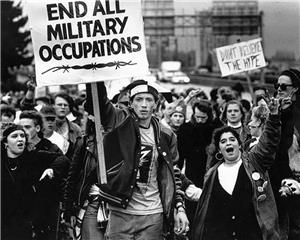On January 14, 1991, 2,500 anti-war protesters march in downtown Seattle against the Gulf War. Approximately two dozen people are arrested for stopping traffic on the Interstate 5 freeway. Two days later, air attacks by coalition forces against Iraq inaugurate Operation Desert Storm.
In August 1990, Iraqi forces invaded Kuwait on the Persian Gulf. The United States responded by deploying forces to defend Saudi Arabia to the south. This response was called Operation Desert Shield. The buildup continued and President George Bush obtained both international and congressional support for a military solution. A coalition to oppose Iraq was formed, consisting of Middle Eastern and European nations. January 15, 1991, was set as a deadline for Iraq to withdraw its forces from Kuwait.
In Seattle, reservists were called to active duty and security measures against terrorism were upgraded. On January 12, approximately 1,500 people gathered at Gas Works Park in Seattle to protest the impending war. Other protests followed in Seattle and across the nation. On January 14, 1991, some 2,500 anti-war demonstraters marched through downtown Seattle. About 25 people were arrested for blocking traffic on I-5.
The anti-war protests spawned demonstrations in support of U.S. policy and in support of service members. Operation Homefront held rallies in Seattle, often coincident with anti-war protests.
Iraq did not withdraw and the U.S. and coalition forces launched six weeks of air attacks to disable Iraq's military. Iraq responded with ballistic missile attacks on Saudi Arabia and on Israel. On February 23, 1991, the ground assault against Iraqi forces in Kuwait began. A cease fire was declared 100 hours later with Iraqi forces defeated.
Ten Washington men died in the conflict.

